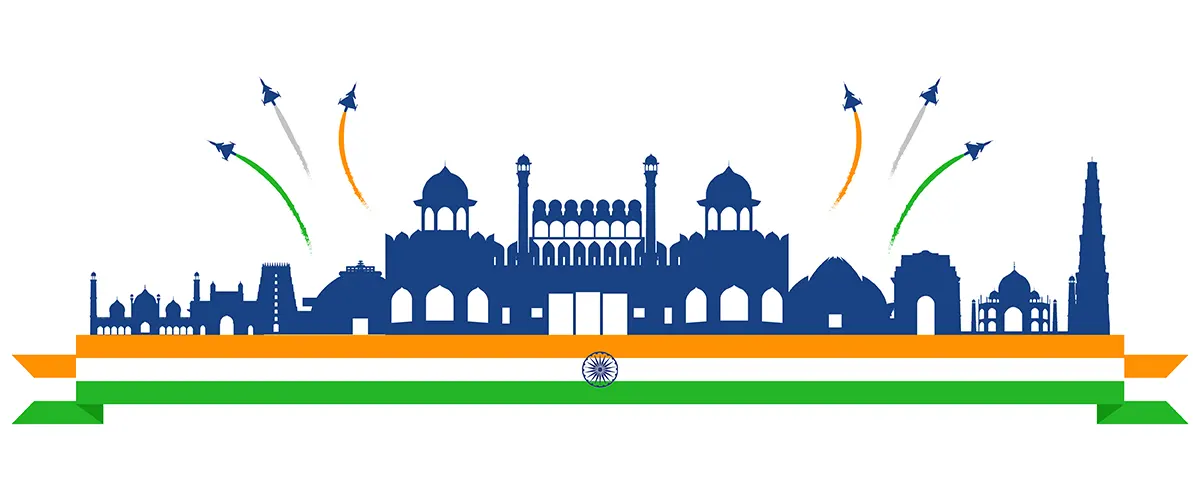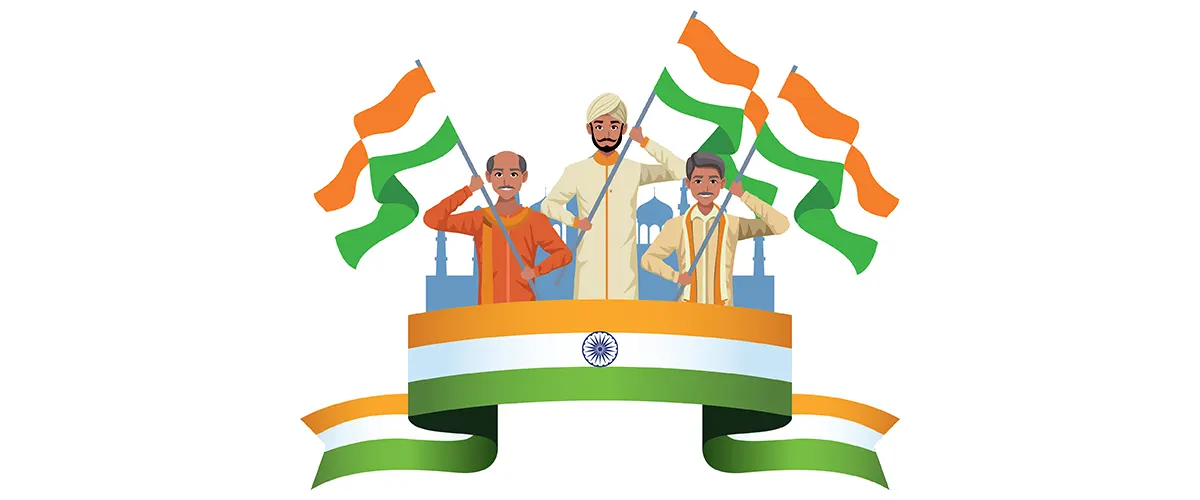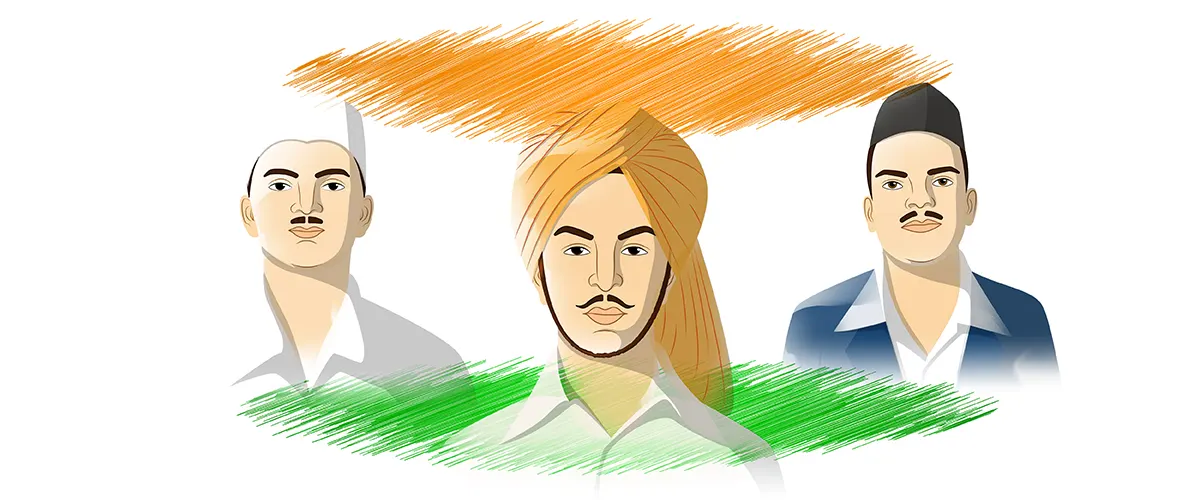As the sun rises on August 15th, 2024, the air is filled with an undeniable sense of patriotism and pride in India. Independence Day 2024, marks yet another year of the nation’s liberation from colonial rule. However, as the nation gears up to celebrate this momentous day, a peculiar question arises: is it the 77th or the 78th celebration of Independence?
In this blog as we delve into the history, significance, and intriguing aspect of the year count of Independence Day, shedding light on why this day holds an irreplaceable position in India’s past, present, and future.
- ▪ History of Independence Day
- ▪ Independence Day Theme 2024
- ▪ Significance of Independence Day 2024
- ▪ 77th or 78th Celebration?
- ▪ Traditions and Celebrations
- ▪ Role of Leaders in Achieving Independence
- ▪ Modern-day Relevance of Independence Day
- ▪ Independence Day Across the Country
- ▪ Independence Day in Popular Culture
- ▪ FAQs

History of Independence Day
Before delving into the information of Independence Day, let’s revisit the history of this day.
The history of Independence Day recounts India’s arduous journey to freedom from British colonial rule. Rooted in the 19th century, the desire for self-governance gained momentum with events like the Indian Rebellion of 1857 and the Swadeshi Movement. Mahatma Gandhi’s philosophy of nonviolent resistance reshaped the struggle, highlighted by the Salt March in 1930.
World War II strained British resources, amplifying demands for independence. The Quit India Movement in 1942 and leaders like Jawaharlal Nehru and Subhas Chandra Bose intensified the call for autonomy. Finally, on August 15, 1947, after 190 years of British dominion, India achieved freedom.
The Indian Independence Act of 1947 marked this historic transition, dividing the subcontinent into India and Pakistan. Every 15th August honours these sacrifices and triumphs, reflecting the nation’s unyielding spirit and unity in the pursuit of sovereignty.
Independence Day Theme 2024
The theme of India Independence Day 2024 would be ‘Viksit Bharat’. The literal definition of ‘Viksit Bharat’ in English would be ‘Developed India’. This theme is in sync with the 100-year plan of the government which is to transform the country into a Developed Nation by 2047.
“The poor have got security as well as dignity in the country for the first time. Those who were made to feel for decades that they are a burden on the development of the country, today they are speeding up the development of the country.” Narendra Modi, the Prime Minister of India. With initiatives like ‘Ensuring All-Round Development for Tribals’ and ‘Garib Kalyan Desh Ka Kalyan’, and many more, the government aims to work towards the nation’s development goal.
Significance of Independence Day 2024
Independence Day holds immense significance for India, embodying core values and honouring the sacrifices of freedom fighters while remaining relevant in contemporary times. It stands as a tribute to the nation’s cherished ideals, representing freedom, democracy, and unity amidst diversity.

The celebration of Independence Day 2024 will foster a sense of pride in India’s pluralistic heritage and the importance of individual rights within a collective identity.
- The day pays homage to the relentless determination and sacrifices of countless freedom fighters who endured adversities, imprisonment, and even death for the vision of a liberated nation. Their unwavering commitment continues to inspire citizens to uphold the principles of justice, equality, and liberty.
- A reminder that the struggle for freedom and progress persists, transitioning from political autonomy to addressing pressing socio-economic and global challenges. The occasion encourages introspection on the strides made and the hurdles that endure, such as poverty, inequality, and environmental issues.
- It reinforces national unity, transcending divisions of caste, creed, and region. The festivities, characterized by flag hoisting, parades, and cultural displays, celebrate India’s diverse tapestry while reinforcing the shared essence of being Indian.
- It signifies the collective triumph, the principles binding citizens, and the ongoing pursuit of an equitable and prosperous society.
As India navigates modern challenges, Independence Day 2024 will serve as a guiding light, illuminating the path toward a future that respects its storied history while embracing new opportunities.
77th or 78th Celebration?
As India prepares to celebrate Independence Day 2024 on August 15, a question emerges: is this the 77th or 78th celebration? The confusion arises from counting the year 1947 as the first celebration. It would be the 77th celebration, but some argue that the inaugural year should be included, making it the 78th.
The historical timeline unfolds as follows:
- 1947: 1st Celebration
- 1948 to 2023: Sequential count
- 2024: The dilemma – 77th or 78th?
Regardless of the count, each year symbolizes India’s progress and dedication to its ideals. The debate adds an intriguing layer to the festivities, reflecting the nation’s unity, growth, and steadfastness. As India commemorates another milestone with Independence Day 2024, let’s answer the mystery question.
The answer to whether it’s the 77th or 78th celebration: This is the 78th Independence Day.
Traditions and Celebrations

Independence Day 2024 celebrations in India embrace diverse traditions that echo the nation’s unity and patriotic fervour.
- Central to these festivities is the flag-hoisting ceremony, where the tricolour flutters in government offices, schools, and public spaces, symbolizing India’s aspirations and unity.
- Cultural programs amplify the celebration’s essence, showcasing India’s rich heritage through music, dance, and drama. These performances not only entertain but also reinforce a sense of national identity and camaraderie.
- Prime Minister addresses the nation, offering reflections on progress, addressing challenges, and outlining the roadmap ahead. This speech serves as a beacon of inspiration and guidance, galvanizing the nation.
- The armed forces’ parades and displays underscore India’s strength and commitment to safeguarding its sovereignty.
- Citizens participate by donning the tricolour, while public spaces bloom with decorations.
- Community service initiatives underscore the day’s significance, uniting citizens in honouring freedom’s legacy.
In a nutshell, Independence Day traditions and celebrations weave India’s diverse culture, unity, and aspirations into a vibrant tapestry. These rituals pay homage to the past, celebrate the present, and ignite collective visions for the future, fostering a commitment to uphold the values for which generations have strived.
Role of Leaders in Achieving Independence

The journey to India’s freedom was guided by visionary leaders whose influence reshaped history. Mahatma Gandhi and Jawaharlal Nehru, whose strategies and movements left an indelible mark on the nation’s pursuit of liberty.
Gandhi’s philosophy of nonviolent resistance, epitomized by the Salt March, showcased the power of civil disobedience. His emphasis on truth and unity galvanized millions, pressuring the British colonial regime to address India’s aspirations.
Nehru, a charismatic leader, navigated the political landscape as a cornerstone of the Indian National Congress. His vision for a democratic, modern India resonated with the masses. His “Tryst with Destiny” speech on the eve of independence encapsulated the nation’s hopes as it embarked on a new era.
Leaders like Subhas Chandra Bose, Sardar Vallabhbhai Patel, and Bhagat Singh added diverse dimensions to the movement. Bose’s Azad Hind Fauj sought international support, Patel’s adept negotiation united princely states post-independence, and Singh’s bravery became a symbol of resistance.
Together, their strategic brilliance and unwavering determination birthed movements forged alliances, and ignited a passion that propelled India towards independence. Their legacies stand as a testament to the power of principled leadership in driving monumental change. The sacrifices and strategies of these leaders remain etched in the fabric of India’s history, reminding us that visionary guidance is pivotal in shaping a nation’s destiny.
Modern-day Relevance of Independence Day
Independence Day’s resonance in contemporary times stems from its enduring relevance. Commemorating 1947’s liberation, it illuminates the sacrifices of the past, grounding today’s challenges in the lessons of history.
The sacrifices of freedom fighters remain a guiding light, underscoring the significance of perseverance and courage in achieving progress. This shared legacy offers perspective and inspiration to navigate present complexities.
The values of freedom and democracy, integral to the freedom movement, remain paramount. In a dynamic world, these principles continue to shape decisions that impact society, fostering inclusivity, and progress.
It prompts introspection, aligning the nation’s journey with global realities. It highlights unity amid diversity and calls for active engagement in contemporary issues, harmonizing national identity with global responsibility.
In essence, it serves as a living testament to the sacrifices that paved the way for present freedoms. It serves as a compass, guiding India’s path forward while anchoring it in the values that bind its diverse populace.
Independence Day Across the Country
Independence Day resonates uniquely across India’s regions, as each adds its local customs and traditions to the nationwide celebration. In the north, Punjab’s dances and Himachal’s rituals infuse cultural pride. Moving east, West Bengal’s art shines, while the northeast integrates indigenous elements.
In the south, grand parades blend with Kerala’s Onam, and the west enlivens with Garba during Navratri. Jammu and Kashmir and Union Territories display their unique colours amid national unity.
Schools, colleges, and organizations nationwide contribute with cultural events and community service, shaping a responsible future generation. The essence of local traditions enriches the celebration, forming a tapestry of diversity within unity, and painting a harmonious picture of patriotism across India. It is also celebrated in various local communities across the nation as it is a public holiday or a gazetted holiday.
Independence Day in Popular Culture
Beyond historical accounts, Independence Day resonates in India’s popular culture. The celebration is incomplete without iconic films like “Lagaan”, “Border” and “Rang De Basanti,” which portray the relevance of freedom struggles. At the same time, songs like “Ae Mere Watan Ke Logon” evoke patriotic fervour. Literature, including “Train to Pakistan” and “Freedom at Midnight,” offers poignant insights.
Visual arts immortalize leaders and the tricolour flag, while various forms of expression ensure the flame of freedom endures. These cultural interpretations weave the theme of independence into the nation’s creative identity, connecting the past with contemporary audiences and instilling timeless values of liberty, resilience, and unity.
As Independence Day dawns, we find ourselves immersed in the saga of India’s journey from colonial subjugation to a sovereign nation. Let this day be a reminder that while history anchors us, our collective actions today mould the destiny of tomorrow, ensuring that the spirit remains a guiding light that illuminates India’s path to progress, unity, and prosperity.
Happy Independence Day 2024!
Jai Hind!
Checkout: Independence Day 2024 Speech in English for Students and Independence Day Essay in English
FAQs
Q1. When does India celebrate its Independence Day 2024?
Ans. India celebrates Independence Day on 15th August.
Q2. What is the theme of the 78th Independence Day?
Ans. The theme of the 78th Independence Day is ‘Viksit Bharat’.
Q3. Why is the tricolour flag hoisted on Independence Day?
Ans. The flag represents India’s identity and aspirations. Hoisting it symbolizes the nation’s unity, pride, and commitment to the values of freedom, democracy, and justice.
Q4. Why is Independence Day important?
Ans. Independence Day holds immense significance as it marks the end of nearly two centuries of British dominance and signifies the dawn of India’s sovereignty and self-governance.

